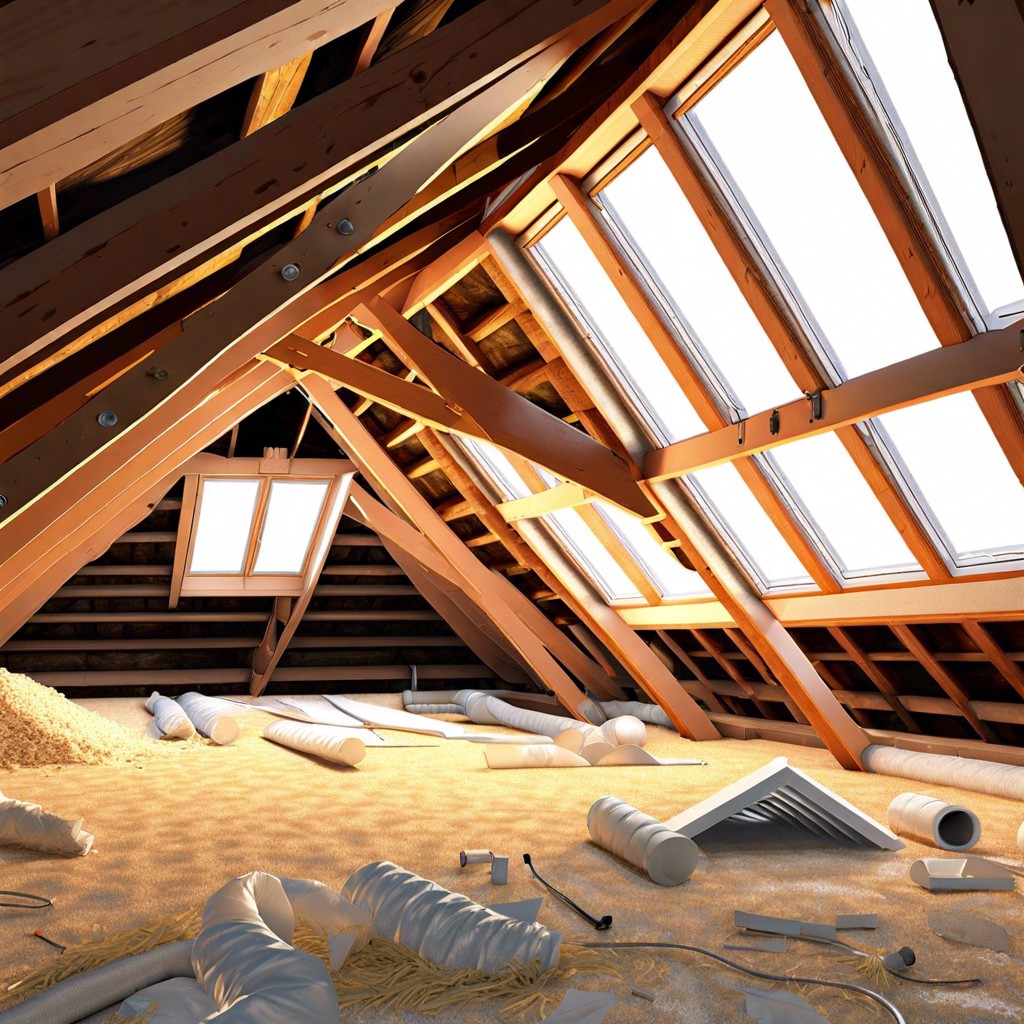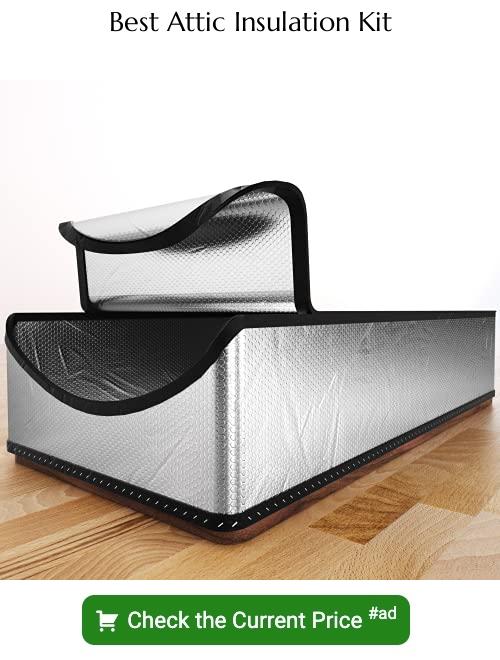Last updated on
This comprehensive guide will provide you with step-by-step instructions to effectively insulate your attic roof rafters, enhancing your home’s energy efficiency and reducing heating costs.
Key takeaways:
- Assess current insulation and ventilation before adding new insulation
- Select the right materials and safety gear for insulating roof rafters
- Follow a step-by-step guide to properly install insulation between rafters
- Understand the cost factors involved in insulating roof rafters
- Attic insulation benefits energy efficiency and roof longevity
Assessing Current Insulation and Ventilation

Prior to adding new insulation, thoroughly inspect your attic space. Look for existing insulation levels; you’ll find most homes have some form of batt or loose-fill insulation already in place. Use a ruler or a tape measure to determine the depth of this insulation and note any areas where it appears compressed or inadequate.
Evaluating the ventilation is equally crucial to prevent moisture build-up that can compromise both the insulation and the roof structure. Check for soffit and ridge vents. These should be clean and unobstructed to ensure proper air flow. Additionally, while inspecting, be keen to identify any signs of mold or water damage, as these issues require remediation before insulation can be considered effective.
To assess both insulation and ventilation properly, choose a cool, dry day and wear appropriate safety gear, such as gloves and a dust mask. This initial inspection will guide your selection of materials and techniques, ensuring that your attic is prepared for efficient insulation.
Materials Required for Insulating Roof Rafters
To insulate your attic roof rafters effectively, you will need specific materials that cater to both the insulation process and safety precautions. Start by selecting the right type of insulation; options include batts (fiberglass or mineral wool), rigid foam boards, and spray foam. The R-value you choose should meet local building codes for energy efficiency.
To secure batt insulation, have wire mesh on hand to prevent sagging between rafters. Furring strips can be used to create a ventilation gap beneath the roof sheathing if installing rigid foam boards.
You will also need:
- A utility knife for cutting insulation to size.
- A staple gun and staples for securing wire mesh and batts.
- Construction adhesive for affixing rigid foam boards.
- Caulk or foam sealant to address air leaks around edges and gaps.
- Safety gear, including gloves, a dust mask or respirator, and eye protection.
Remember to verify compatibility between the materials selected and the existing structure of your home to ensure a successful insulation project.
Step-by-Step Guide to Installing Insulation Between Roof Rafters
Begin by ensuring the attic space is clear of any obstructions and that the roof rafters are accessible. It’s essential for safety and efficacy that you wear protective gear, including gloves, a mask, and goggles.
Measure the distance between rafters to determine the width of the insulation batts or rolls you’ll need. For optimal energy efficiency, select insulation with the appropriate R-value for your climate zone.
Cut the insulation material to size using a straightedge and a utility knife. Insulation should fit snug but not be compressed, as over-compressing can reduce its effectiveness.
Starting from the edge of the attic, push the insulation up between the rafters, ensuring the vapor barrier (if present) faces the interior of the home. It’s important to avoid blocking soffit vents with insulation, which could compromise attic ventilation.
Secure the insulation in place with rafter vents or baffles that maintain a clear air channel from the soffit vents to the attic. These should be installed prior to the insulation if they aren’t already in place.
For a more finished look or additional insulation, you can also install rigid foam insulation board against the rafters, followed by a layer of drywall or wood paneling. Ensure to seal any gaps with caulk or foam spray to prevent air leaks.
Remember, leaving space for air to circulate beneath the roof sheathing is crucial to avoid moisture buildup and to preserve the longevity of the roof structure.
Understanding the Cost Factors of Insulating Roof Rafters
The cost of insulating roof rafters can vary widely due to several factors. Material choice is primary, with fiberglass batts typically being the most cost-effective, while spray foam is a higher-end option due to its better insulation properties and airtightness. The R-value, or thermal resistance, also influences price; higher R-values provide better insulation but at a greater cost.
Labor expenses are another consideration. DIY insulation can save on costs, but professional installation ensures proper fitting, which is vital for maximizing energy efficiency and preventing issues such as moisture buildup.
The size and accessibility of the attic space will affect the total price. Larger areas require more material and potentially more labor. Difficult-to-access spaces might incur additional charges due to the increased time and specialized equipment needed to complete the job.
Lastly, any extra features, such as installing radiant barriers or attic ventilation alongside insulation, will add to the overall expense. These enhancements improve performance but should be factored into the budget.
By understanding these cost variables, homeowners can make informed decisions to balance their insulation needs with their financial constraints.
How Attic Insulation Benefits Roof Longevity and Energy Efficiency
Insulating your attic can lead to substantial energy savings by reducing the amount of heat that escapes during the winter and the amount of heat that penetrates during the summer. This thermal barrier means your heating and cooling systems won’t have to work overtime to maintain a comfortable indoor temperature, leading to lower utility bills.
Proper attic insulation also minimizes the risk of ice dams in colder climates. Ice dams form when heat escapes and melts snow on the roof, which then refreezes at the eaves, potentially causing water damage. By maintaining a consistent attic temperature, insulation helps prevent this cycle.
In addition to energy efficiency, a well-insulated attic helps prevent moisture build-up. Too much moisture can lead to mold growth and wood rot, compromising both your home’s air quality and the structural integrity of your roof. By keeping your attic dry, insulation not only enhances your roof’s longevity but also promotes a healthier living environment.
FAQ
Should you insulate attic roof rafters?
Yes, you should insulate attic roof rafters if the air distribution is in the attic space to move it into the conditioned space.
What is the best way to insulate an attic roof?
The optimal method to insulate an attic roof is by employing economical and easier-to-install fiberglass batts or rolls and placing them between the joists in the attic.
What should I insulate between roof rafters?
Insulate between roof rafters using Celotex for optimal insulation in both new build houses and older properties.
How do you insulate ceiling rafters?
Insulating ceiling rafters involves placing insulation between the rafters, pressing it firmly into place, and if using loose-fill insulation, a blower is used, after which any gaps or spaces between the insulation and rafters are sealed with foam insulation sealant or caulking.
What materials are typically used for insulating attic roof rafters?
Common materials for insulating attic roof rafters typically include fibreglass batt, rigid foam board, and sprayed foam insulation.
What factors should be considered when insulating your attic roof?
When insulating your attic roof, you should consider factors such as the type of insulation, the climate of your location, ventilation needs, and your home’s energy efficiency requirements.
How significant is the R-value in term of insulating attic roof rafters?
The R-value is extremely significant in terms of insulating attic roof rafters as it measures the resistance to heat flow, with higher values meaning better insulation.





